


JOHN CABOT c1450 -
xxxxxThe 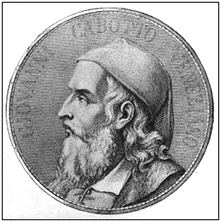 navigator and explorer John Cabot was born Giovanni Caboto, probably in Genoa, Italy. He became a citizen of Venice in 1476, and doubtless learnt his seamanship and navigational skills while sailing in the Mediterranean. He might well have moved to England with his family somewhere around 1484 and settled in Bristol, though this move might have been much later. His reason for coming to England is not known, but it appears that he had been convinced for some time that there was a westward sea route to the Orient, and he may well have thought that a route further to the north would be more direct. When in 1493 news was heard that Christopher Columbus had indeed discovered new land in that direction, he was anxious to do likewise. In 1496 he received the support of Henry VII and the financial backing of certain Bristol merchants for a voyage of discovery across the Atlantic.
navigator and explorer John Cabot was born Giovanni Caboto, probably in Genoa, Italy. He became a citizen of Venice in 1476, and doubtless learnt his seamanship and navigational skills while sailing in the Mediterranean. He might well have moved to England with his family somewhere around 1484 and settled in Bristol, though this move might have been much later. His reason for coming to England is not known, but it appears that he had been convinced for some time that there was a westward sea route to the Orient, and he may well have thought that a route further to the north would be more direct. When in 1493 news was heard that Christopher Columbus had indeed discovered new land in that direction, he was anxious to do likewise. In 1496 he received the support of Henry VII and the financial backing of certain Bristol merchants for a voyage of discovery across the Atlantic.
xxxxxHe sailed 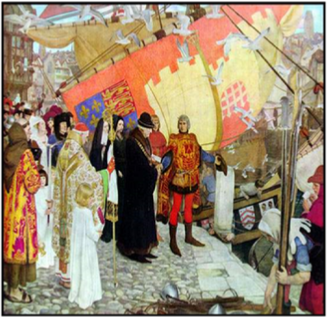 from Bristol
from Bristol 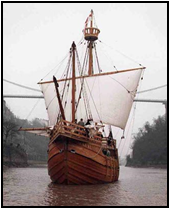 in May 1497 (illustrated left) with no more than 20 men in a small ship called Matthew, and landed in North America -
in May 1497 (illustrated left) with no more than 20 men in a small ship called Matthew, and landed in North America -
xxxxxCabot now organised a second, larger expedition, convinced that, having reached the northern coast of Asia, he would be able to find his way to Japan, then known as Cipangu, the land of gems and spices. This time five ships and a force of some 200 men set out, leaving in May 1498. It is known that, soon afterwards, one of the ships was damaged and had to seek shelter somewhere 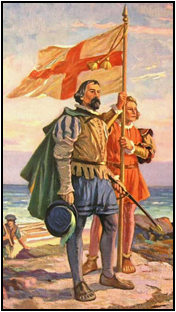 along the Irish coast, but virtually nothing is known about the fate of the four remaining vessels. One theory is that Cabot reached the east coast of Greenland where, because of the severe cold, his crews mutinied and all the ships were lost. It certainly seems that the expedition perished. If only one of the ships had returned there would surely have been some information to be had about the fate of the second voyage. However, it appears that certain documents have come to light which suggest that Cabot was back in London in May 1500!
along the Irish coast, but virtually nothing is known about the fate of the four remaining vessels. One theory is that Cabot reached the east coast of Greenland where, because of the severe cold, his crews mutinied and all the ships were lost. It certainly seems that the expedition perished. If only one of the ships had returned there would surely have been some information to be had about the fate of the second voyage. However, it appears that certain documents have come to light which suggest that Cabot was back in London in May 1500!
xxxxxWhilst Cabot had staked a claim for England in the New World, there was no immediate follow-
xxxxxIncidentally, Bristolians (residents of Bristol) are likely to claim that John Cabot discovered the mainland of America, Columbus only discovered offshore islands! They also claim that America was named after the High Sheriff of Bristol at that time, one Richard Amerycke, who helped to finance the voyage and gave Cabot a pension on his return! It is generally considered, however, that the continent was named after the Florentine navigator Amerigo Vespucci (1501) at the beginning of the 16th century. ……
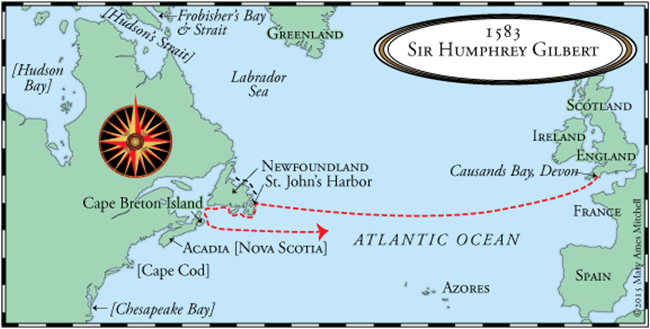
xxxxx…… It is not known exactly where Cabot landed in North America, but Newfoundland is thought to be the likely place. What is known, however, is that in 1583 five ships under the command of the English adventurer Sir Humphrey Gilbert (1539-
xxxxxIt was in 1496 that the Italian navigator John Cabot, then living in England, received the support of Henry VII, and financial backing, to find a westward route to the Orient. He sailed from Bristol in May 1497 and landed in North America -



Acknowledgements
Cabot: an imaginary medallion portrait, designed by the artist Carlo Barrera Pezzi, and contained in his Memory of Giovanni Cabot, published in Venice in 1881 – Library and National Archives of Canada, Ottawa. Departure: colour lithograph after the English painter Ernest Board (1877-
H7-